Chinese Bronze refers to the alloy of pure copper and other chemicals like stannum, plumbum, nickel, and phosphorus. It has a history of 3000 years, spanning from the Xia Dynasty to the Han Dynasty. The Chinese Bronze Vessels are most found from the Bronze Age of China (1500-300 B.C), representing the culture and technology of the Xia, Shang, and Zhou Dynasties.
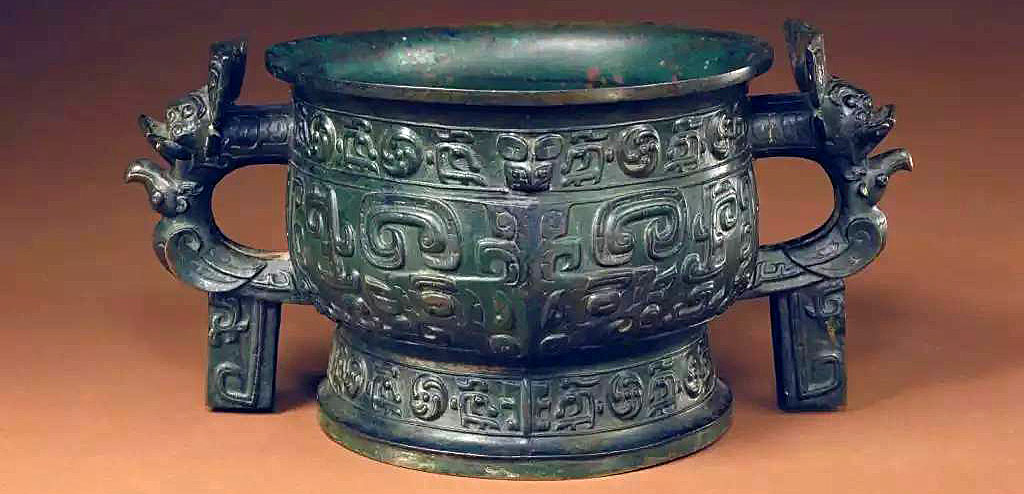
It’s unclear when exactly the Chinese bronze vessels originated. Still, historical records suggest that some copper smelting emerged during the reign of Xia Qi (the second king of the Xia Dynasty). The archaeological excavations confirmed that the earliest Chinese bronze vessels were from the Xia Dynasty (2100 - 1600 B.C.). In 1973, a fraction of circular copper sheet was discovered in a house of Jiangzhai Ruins of Yangshao culture. It was authenticated to belong to a brass vessel from 4700 B.C. Two years later, a small bronze knife belonging to 3000 B.C. was excavated from the Majiayao Ruins of Gansu province, indicating the Xia Dynasty might be the beginning of the Bronze Age.
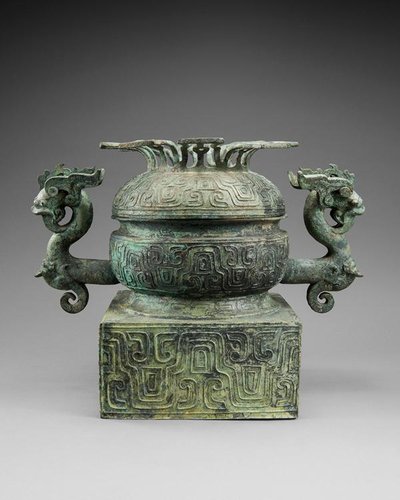
Later, archaeologists found residues, fractions, and remains of the copper crucible in Erlitou ruins and Donggangou ruins (both belong to the Xia era) of Henan province, further proving that the bronze vessels appeared in Xia Dynasty.
The bronze vessels discovered from the Xia Dynasty were mainly for sacrificial and fighting purposes, settling the primary function of Chinese bronze vessels. The bronze vessels excavated from Erlitou ruins represented the Xia era bronze vessels, including the bronze tools, weapons, ornaments, and containers. Most of the bronze containers were Jue (vessels to contain alcohol). Those bronze Jues were made in Hefan Method (prepare the small pieces of the vessel first, then fit them together), and their forms and patterns somewhat resemble the stone and pottery vessels from Neolithic Age. The bronze Ding, Ge, Jue, and Jia also have their corresponding prototypes in pottery. Even the ornamental patterns and the inscriptions of the bronzes were found in stone and pottery wares. The colored drawings like the patterns of cloud, lightning, and the crouching dragon found in the potteries of Longshan ruins (2500-2000 B.C.) also reappeared in the bronze wares discovered later.
Since the Shang Dynasty, the development of bronze culture reached its prime times. Shang era bronze vessels can be roughly categorized into two kinds based on their phases, namely the Erligang era bronze wares and Yinxu era bronze wares. 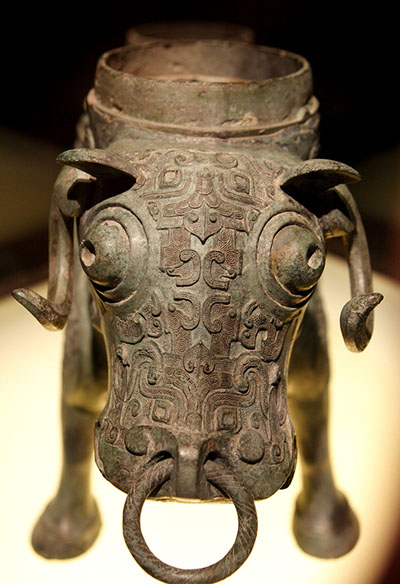
Erligang era belongs to the early Shang Dynasty before Shang King Pan Geng moved the capital city from Yan (current Qufu, Shandong province) to Yin (current Anyang, Henan province). The bronze vessels from the Erligang era were mostly founded in Erligang Ruins and Liulige of Hui county of Henan province; they succeeded the traits of those from the Erlitou age but were more diversified. There were utensils like Ding, Ge, and Yan, drinking vessels like Hu, Jue, Jia, Zun, You, Hu and Lei, water vessels like Pan and He, weapons like Dagger-axe, Spear, Knife, and Arrowhead, as well as tools like Axe and Ben. Craftsmen in the Erligang age were able to build great bronze wares. In 1974, a square Ding with 100cm in height and 82.4km in weight was excavated in Zhangzhai, Shandong province. In 1982, similar square Dings were discovered in Zhengzhou. Henan province. Besides, the earliest inscriptions were found on the bronze vessels of the Erligang era.
The bronze wares from the Yinxu era represented the first peak of the Chinese bronze development. They were discovered in many areas like Inner Mongolia, Coastal Shandong, Shanxi, and Guangxi, with the capital city Yin in the center. The bronze vessels were bigger, better-qualified, more stylish, more elaborate, and gorgeous with improved techniques. The most significant bronze object ever discovered, the Houmuwu Square Ding, was from this time. Not only were many sacrificial bronze vessels, weapons, and tools found, there were bronze instruments, carts, and wares for horses.
The most prominent feature of Shang Dynasty bronze wares is that Shang people liked to decorate the bronze vessels with animal drawings, like Four-goat Zun, Elephant Zun, Pig Zun, and Xiao Zun. The earliest inscriptions of bronze vessels appeared from the early Shang Dynasty. However, whether those patterns are characters is still unclear.
There are five categories of bronze vessels: drinking vessels, food vessels, water vessels, instruments, and weapons.
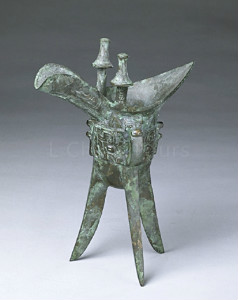
Jue (爵): Jue refers to the vessel used for pouring drinks; it’s the earliest bronze vessel used on sacrificial occasions. A Jue usually has a small groove in front to let the drinking content coming out, a Pan in the back easy to carry, and a pillar inside (functioning as a filter perhaps). There are three feet to hold the whole vessel.
Jue (角): Unlike the Jue mentioned earlier, this Jue functions like today’s drinking cup. There is no pillar and groove on it. It’s about one-fourth in the capacity of the Jue mentioned before. The earliest Jue excavated is housed in Shanghai Museum.
Zun(尊): Zun refers to big or medium-sized drinking containers.
Hu (壶): Hu is similar to today’s pot that used to contain drinkings.
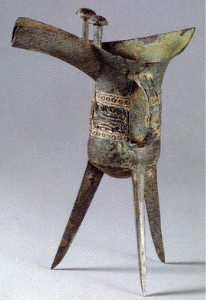
You (卣): You is another kind of drinking container, prevailing in the late Shang and early Zhou Dynasties.
Gong (觥): Gong is similar to You, appeared at the same time as You.
Yi (彝): Yi is also a drinking container in a square shape that appeared in the late Shang Dynasty.
Dou (豆): It’s a vessel specially for preserving pickles, meat paste, and seasonings. Appeared in the late Shang Dynasty and prevailing in both the Spring and Autumn Period and the Warring Period, the Dou is one of the sacrificial wares, usually used in pairs. There were strict regulations on how many Dous one could use. For example, the emperors were allowed 26 Dous, the feudal lords with 16 Dous, senior ministers with 8 Dous, and the junior ministers with 6 Dous. The Bronze Dou with Bell excavated in Baode, Shanxi province, was regarded as the earliest bronze Dou.
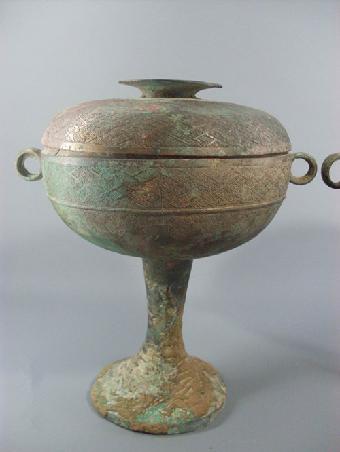
Ding (鼎): It’s used for boiling meat, offering sacrificial animals, and containing food in a feast. Unlike the vessel, the Ding was used during the Shang, Zhou, Qin, Han, even Wei, and Jin Dynasties. It served both as a food container and a ritual vessel, symbolizing hierarchy and power. In ancient China, there were rules about how many Dings people were allowed to use based on their status quo. In Western Zhou Dynasty, the King could use 9 Dings, in which the first Ding must serve ox meat while the rest serve the meat of goat, pig, fish, fat, intestines, grease, fresh fish, and dried meat. The feudal lords could use 7 Dings, containing the same meats as the King’s except two dishes (fresh meat and dried meat). For other ministers in different positions, different amounts of Dings and meats were allowed.
Yan (甗): It’s a utensil used for steaming food. It’s composed of two parts with an apertured cage drawer in between to allow the steam to go through. The upper part can contain rice, and the lower part can contain water. Yan appeared in the early Shang Dynasty and prevailed in Zhou
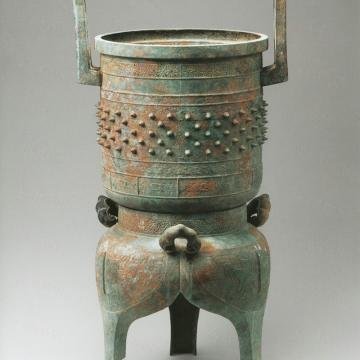 Dynasty and Spring and Autumn Period. It’s a customary burial object.Dynasty and Spring and Autumn Period. It’s a customary burial object.
Dynasty and Spring and Autumn Period. It’s a customary burial object.Dynasty and Spring and Autumn Period. It’s a customary burial object.
Gui (簋): It’s the utensil to contain boiled rice and grains. As one of the essential ritual wares, Gui was used together with Ding on sacrificial and banquet occasions. The King could use eight Guis and lords six Guis. There, many excavated Guis came in pairs.
Dui (敦): It’s the utensil to contain millet, rice, and other grains, developed based on Ding and Gui. Appearing in the middle Spring and Autumn Period, the Dui prevailed in the late Spring and Autumn period until the late Warring Period.
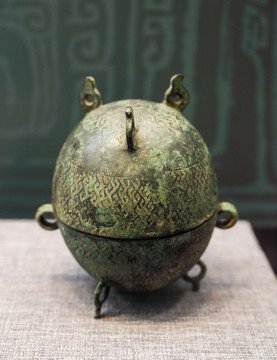
Li (鬲): It’s the vessel for eating porridge. It appeared in the early Shang Dynasty, and the early ones had big stomachs to enable the fillings to be quickly boiled. In the late Shang Dynasty, those big stomachs were gone; most of the bronze Li was used to contain cooked porridge.
Plate: It’s a vessel to contain water, appeared in the early Shang Dynasty and prevailed in the late Shang Dynasty.
Yi (匜): It’s a vessel to contain water for washing hands. It’s usually used together with Plate.
Jian (鉴): It’s the big vessel that used to contain water or ice.
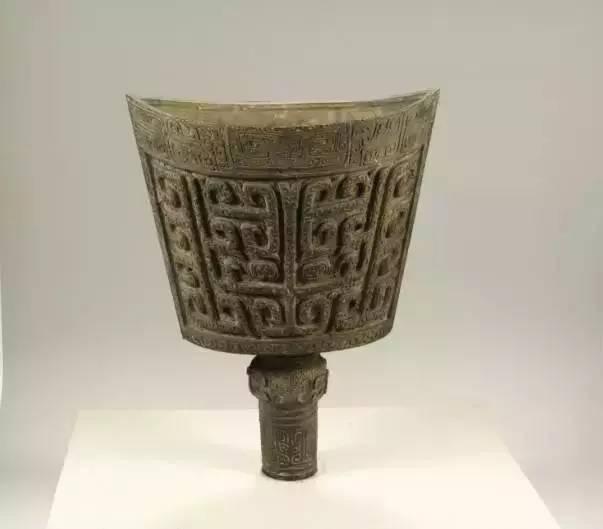
Bell: It’s a kind of percussion instrument prevailing in Western and Eastern Dynasties. There are two kinds of bells, and the one obliquely hang is Yong Bell, while the straightly hanging one is Niu Bell.
Drum: It’s a kind of percussion instrument; very few left today as most of the drums were wooden.
Nao (铙): Also a percussion instrument, the Nao was used to spread the military orders.
Zheng (钲): It’s another percussion instrument used during the marching.
Ge (戈): It’s very common in Shang and Zhou Dynasties and used as a hook.
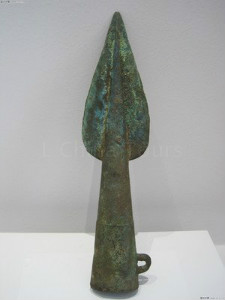
Spear (矛): It’s a weapon with a long handle, used during the sprint.
Yue (钺): It’s a lethal weapon, a lot like an ax, but bigger. Unlike other weapons, Yue is mostly used by the guard of honor or as a funerary object, symbolizing power like a sceptre in the western world.
Ji (戟): It’s a combination of Ge and Spear, with vertical and horizontal blades.
Sword (剑): It’s a weapon that ancient lords and warriors bear every day. Most swords are accompanied by a scabbard.
Simuwu Ding is the largest and heaviest piece of bronze ware in China. In 1939, the Ding was unearthed from Fu Jing’s tomb in An Yang, Henan province and preserved in the National Museum of China.
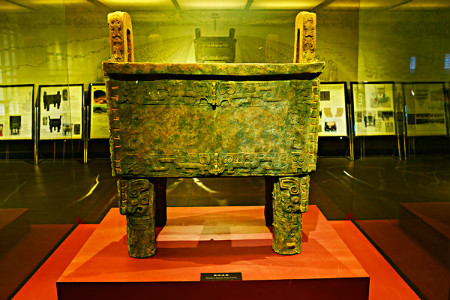
Unearthed in 1938, from a mountain in Ningxiang county, Hunan province, the Four-goat Square Zun is the biggest bronze square Zun from the Shang Dynasty and possessed by the National Museum of China.
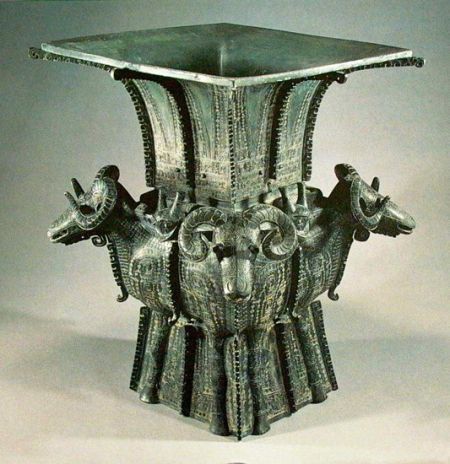
Discovered in Sanxingdui Ruins of Chengdu city, the Upright Bronze Figure is the tallest and most complete existing bronze figure in the world. It’s praised as the King of the World Bronze Figure and collected by the Sanxingdui Museum.
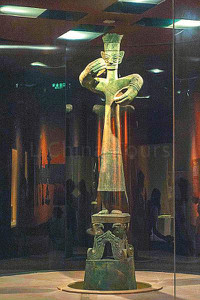
Discovered in Qishan County, Shaanxi province, the Maogong Ding was built by Duke Mao in the late Western Zhou Dynasty. Inside the Ding was an inscription in developed Zhou calligraphy telling how Duke Mao advised Zhou King Xuan. The Ding is collected in Taipei National Museum.
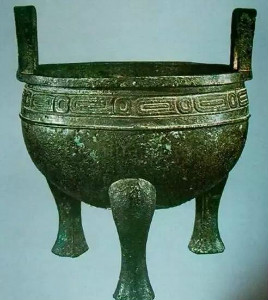
Unearthed from Duke Zheng’s tomb in Xinzheng, Henan province, in 1923, the Lotus and Crane Rectangular Hu was gorgeous, and its making involved many complex techniques that are missing nowadays. It’s now housed in Henan Provincial Museum.
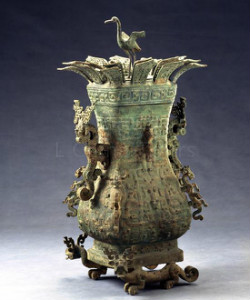
Found in 1965 from a Chu Tomb in Hubei province, the Sword of Goujian is famous for its unusual sharpness and resistance to rust due to a thin layer of chromium on its surface. It’s now in possession of the Hubei Provincial Museum.
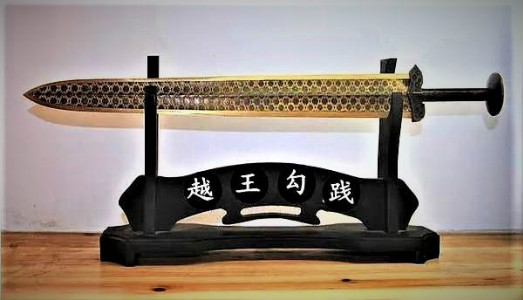
Unearthed in Suizhou city, Hubei province in 1978, the Bianzhong of Marquis Yi of Zeng is the best-preserved, most exquisite, and most complete large-scale instrument in the world. It has changed the music world and was regarded as a scarce treasure. Hubei Provincial Museum now possesses it.
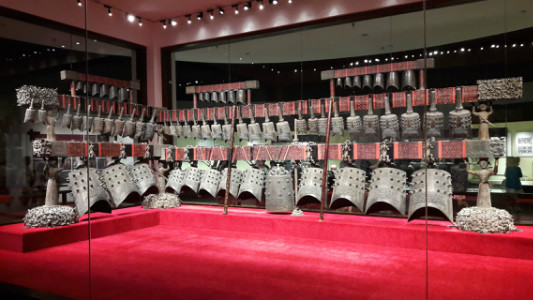
Excavated in Qinshihuang’s Mausoleum in 1980, the Bronze Chariots and Horses are the earliest, biggest, and best-preserved bronze chariots and horses. It has represented the highest smelting and engraving art of the Qin Dynasty. Now, it’s collected in Terracotta Warriors and Horses Museum.
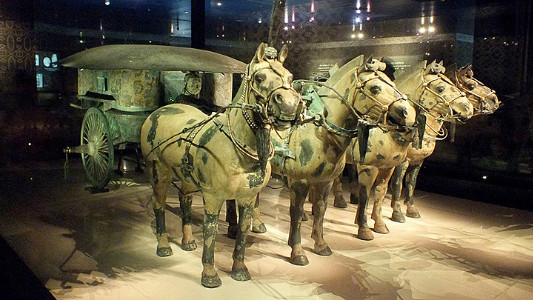
Excavated in Dou Wan (King Jing Liu Sheng in Western Han Dynasty)’s Tomb in 1968, the Changxin Palace Lamp is light, practical, yet gorgeous (unlike other heavy and complicated bronze wares). The ingenious design and superb artistry make the lamp the No.1 Lamp in China.
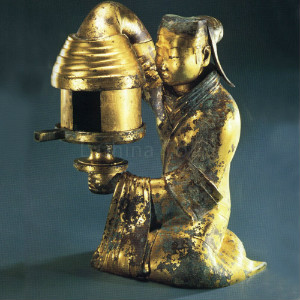
Unearthed in Leitaihan Tomb of Wuwei, Gansu province in 1969, the Galloping Horse Treading on a Flying Swallow stands for the highest foundry industry of ancient China. It’s quite impressive how the ancient craftsmen found the right spot on the swallow to support the whole horse, making it stable in the current position. This relic is now housed in Gansu Provincial Museum. In 1985, Galloping Horse Treading on a Flying Swallow became the logo of the Chinese Tourism Industry.
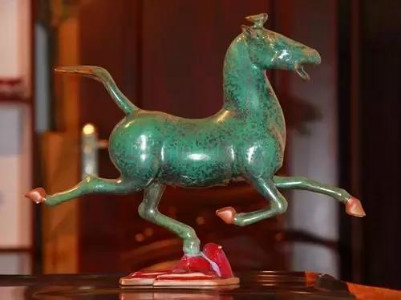
Copyright © 2019 Lily Sun China Tours International, Inc. Terms &conditions | Privacy Policy | Sitemap